
Hypertext is text displayed on a computer display or other electronic devices with references (hyperlinks) to other text that the reader can immediately access. Hypertext documents are interconnected by hyperlinks, which are typically activated by a mouse click, keypress set, or screen touch. Apart from text, the term "hypertext" is also sometimes used to describe tables, images, and other presentational content formats with integrated hyperlinks. Hypertext is one of the key underlying concepts of the World Wide Web, where Web pages are often written in the Hypertext Markup Language (HTML). As implemented on the Web, hypertext enables the easy-to-use publication of information over the Internet.
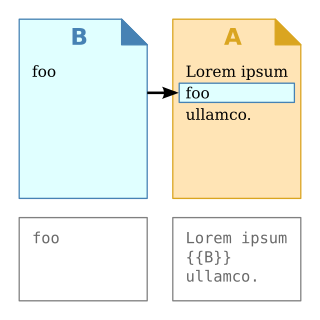
In computer science, transclusion is the inclusion of part or all of an electronic document into one or more other documents by reference via hypertext. Transclusion is usually performed when the referencing document is displayed, and is normally automatic and transparent to the end user. The result of transclusion is a single integrated document made of parts assembled dynamically from separate sources, possibly stored on different computers in disparate places.
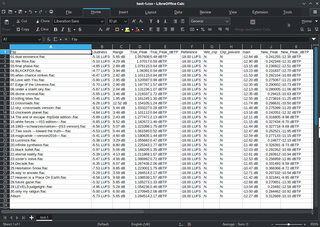
A spreadsheet is a computer application for computation, organization, analysis and storage of data in tabular form. Spreadsheets were developed as computerized analogs of paper accounting worksheets. The program operates on data entered in cells of a table. Each cell may contain either numeric or text data, or the results of formulas that automatically calculate and display a value based on the contents of other cells. The term spreadsheet may also refer to one such electronic document.

Theodor Holm Nelson is an American pioneer of information technology, philosopher, and sociologist. He coined the terms hypertext and hypermedia in 1963 and published them in 1965. According to a 1997 Forbes profile, Nelson "sees himself as a literary romantic, like a Cyrano de Bergerac, or 'the Orson Welles of software'."
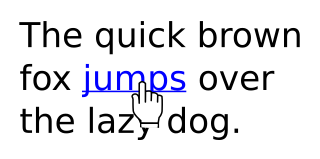
In computing, a hyperlink, or simply a link, is a digital reference to data that the user can follow or be guided to by clicking or tapping. A hyperlink points to a whole document or to a specific element within a document. Hypertext is text with hyperlinks. The text that is linked from is known as anchor text. A software system that is used for viewing and creating hypertext is a hypertext system, and to create a hyperlink is to hyperlink. A user following hyperlinks is said to navigate or browse the hypertext.
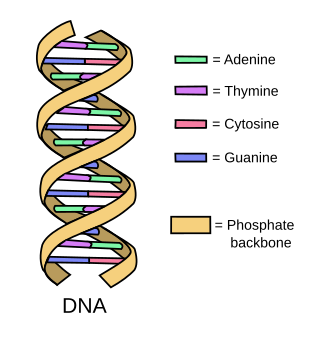
A structure is an arrangement and organization of interrelated elements in a material object or system, or the object or system so organized. Material structures include man-made objects such as buildings and machines and natural objects such as biological organisms, minerals and chemicals. Abstract structures include data structures in computer science and musical form. Types of structure include a hierarchy, a network featuring many-to-many links, or a lattice featuring connections between components that are neighbors in space.
Project Xanadu was the first hypertext project, founded in 1960 by Ted Nelson. Administrators of Project Xanadu have declared it superior to the World Wide Web, with the mission statement: "Today's popular software simulates paper. The World Wide Web trivialises our original hypertext model with one-way ever-breaking links and no management of version or contents."
Hypermedia, an extension of hypertext, is a nonlinear medium of information that includes graphics, audio, video, plain text and hyperlinks. This designation contrasts with the broader term multimedia, which may include non-interactive linear presentations as well as hypermedia. The term was first used in a 1965 article written by Ted Nelson. Hypermedia is a type of multimedia that features interactive elements, such as hypertext, buttons, or interactive images and videos, allowing users to navigate and engage with content in a non-linear manner.

Solid modeling is a consistent set of principles for mathematical and computer modeling of three-dimensional shapes (solids). Solid modeling is distinguished within the broader related areas of geometric modeling and computer graphics, such as 3D modeling, by its emphasis on physical fidelity. Together, the principles of geometric and solid modeling form the foundation of 3D-computer-aided design, and in general, support the creation, exchange, visualization, animation, interrogation, and annotation of digital models of physical objects.

In mathematics, a regular polytope is a polytope whose symmetry group acts transitively on its flags, thus giving it the highest degree of symmetry. In particular, all its elements or j-faces — cells, faces and so on — are also transitive on the symmetries of the polytope, and are themselves regular polytopes of dimension j≤ n.

Visualization, also known as Graphics Visualization, is any technique for creating images, diagrams, or animations to communicate a message. Visualization through visual imagery has been an effective way to communicate both abstract and concrete ideas since the dawn of humanity. from history include cave paintings, Egyptian hieroglyphs, Greek geometry, and Leonardo da Vinci's revolutionary methods of technical drawing for engineering purposes that actively involve scientific requirements.
Essbase is a multidimensional database management system (MDBMS) that provides a platform upon which to build analytic applications. Essbase began as a product from Arbor Software, which merged with Hyperion Software in 1998. Oracle Corporation acquired Hyperion Solutions Corporation in 2007. Until late 2005 IBM also marketed an OEM version of Essbase as DB2 OLAP Server.
Zigzag is a jagged, regular pattern.
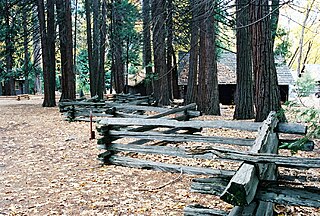
A split-rail fence, log fence, or buck-and-rail fence is a type of fence constructed in the United States and Canada, and is made out of timber logs, usually split lengthwise into rails and typically used for agricultural or decorative fencing. Such fences require much more timber than other types of fences, and so are generally only common in areas where wood is abundant.
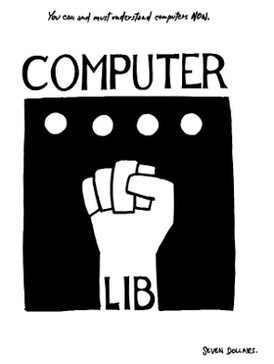
Computer Lib/Dream Machines is a 1974 book by Ted Nelson, printed as a two-front-cover paperback to indicate its "intertwingled" nature. Originally self-published by Nelson, it was republished with a foreword by Stewart Brand in 1987 by Microsoft Press.
Roger Everett Gregory is a US computer programmer, technologist, and scientist. Gregory's work in project Xanadu made him one of the earliest pioneers of hypertext technology, which helped lay the foundations for the hyperlink technology that underlies the World Wide Web. Gregory attended the University of Michigan as a mathematics major. In the 1970s, he founded the Ann Arbor Computer Club, similar to the West Coast's Home Brew Computer Club.
Hyperland is a 50-minute-long documentary film about hypertext and surrounding technologies. It was written by Douglas Adams and produced and directed by Max Whitby for BBC Two in 1990. It stars Douglas Adams as a computer user and Tom Baker, with whom Adams had already worked on Doctor Who, as a personification of a software agent.

In geometry, a skew polygon is a closed polygonal chain in Euclidean space. It is a figure similar to a polygon except its vertices are not all coplanar. While a polygon is ordinarily defined as a plane figure, the edges and vertices of a skew polygon form a space curve. Skew polygons must have at least four vertices. The interior surface and corresponding area measure of such a polygon is not uniquely defined.
Enfilades are a class of tree data structures invented by computer scientist Ted Nelson and used in Project Xanadu "Green" designs of the 1970s and 1980s. Enfilades allow quick editing, versioning, retrieval and inter-comparison operations in a large, cross-linked hypertext database. The Xanadu "Gold" design starting in the 1990s used a related data structure called the Ent.

Hypertext is text displayed on a computer or other electronic device with references (hyperlinks) to other text that the reader can immediately access, usually by a mouse click or keypress sequence. Early conceptions of hypertext defined it as text that could be connected by a linking system to a range of other documents that were stored outside that text. In 1934 Belgian bibliographer, Paul Otlet, developed a blueprint for links that telescoped out from hypertext electrically to allow readers to access documents, books, photographs, and so on, stored anywhere in the world.













